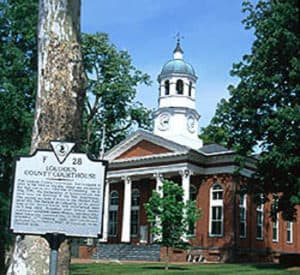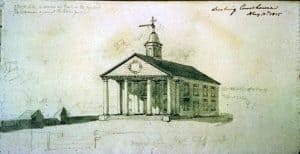History of Loudoun County Courthouses in Leesburg
This paper was written by Michael Gulland, a high school student at St. Albans School in Washington D.C., a Loudoun County resident who interned at the Courthouse in the summer of 1995.
Loudoun County was formed in 1757 from a branch of Fairfax County. Loudoun County is named after John Campbell, who was the Fourth Earl of Loudoun and a Scottish nobleman. Campbell, at the time, was the titular governor of Virginia, from 1756-1758, and a former Commander in Chief of the British armed forces in Virginia.
Most of Leesburg was founded on the property of Nicholas Minor, who petitioned the General Assembly for the construction of a town on his land. Originally named Georgetown after King George I of England, the town’s name was later patriotically changed to Leesburg, in honor of Francis Lightfoot Lee, a signer of the Declaration of Independence. This name change was an excellent way for Leesburg to show its faith and support of our newly founded country.
There have been three courthouses in Loudoun County. The first was built in 1758, overseen by Aeneas Campbell, who was also the first sheriff of the county. The courthouse was fairly small, measuring forty feet by twenty-eight feet in size, and costing 365 pounds. It was constructed of brick and had five windows, which were framed with white oak. The window sashes were made of "well-seasoned pine", and each had shutters with hooks and bolts. The front door was eight feet high and four and a half feet wide. The county court performed executive, legislative and judicial duties. Originally, the county court met only quarterly. The justices of this era received no payment for their services, so only wealthy people who could afford to miss work in order to hold these positions. However, acting as a justice certainly had its rewards, as it enabled that person to function as the center of attention and power in local affairs. The Declaration of Independence was read on the steps of the first courthouse during August Court Days of 1776. It was the first reading of the document anywhere in the state of Virginia.
Loudoun’s first jail was in close proximity to the first courthouse. The jail was built under the supervision of Daniel French, who was hired to build the "gaol and stocks" for 83 pounds. However, the court negligently provided French with either little or poor information regarding the construction of the jail. As result, it ended up unsafe and badly built, certainly not good characteristics of a holding facility. Unable to meet the public’s demands, the county government declared the jail to be inadequate. Its use was terminated on November 14, 1759.
A second and larger courthouse was built in 1811, also of brick. It consisted of four large and beautiful stone pillars, of which there are still remnants in today’s courtyard. Several pieces of these pillars were saved by builder Joseph Layette Norris, and they were returned in 1978 "by caring citizens", as the plaque dedicating them reads. The second courthouse stood until about 1888. That courthouse survived The Civil War and, in fact, was the setting for a shootout between Yankee and Confederate Soldiers on the front lawn.
The third and present courthouse was erected in 1895. It rises on four columns, has double doors, and is capped by a clock and bell housed in a belfry. Other county offices and the Juvenile and Domestic Relations Court adjoin the modern courthouse. In August 1987, the Office of the Commonwealth’s Attorney was transferred to the Valley Bank Building, which is adjacent to the courthouse. The Courthouse is part of the Leesburg Historic District recognized by the Virginia Historic Landmarks Commission.
In front of the courthouse stood a statue of a Confederate soldier. It was designed by F.S. Sievers, and dedicated to the courthouse in 1908. The statue was reclaimed by the Daughters of the Confederacy in 2020 as public pressure increased for its removal.
Stocks and whipping posts have been relocated off the courthouse grounds. They portrayed a vivid image of the harsh methods of law enforcement utilized in our community’s past.
Bibliography:
Bucklen, Mary Kegley and Bucklen, Larrie L. County Courthouses of Virginia, Pictorial Histories Publishing Co., 1989.
Loudoun County…A Reference of Information. Enterprise Productions, 1973. (Compilation of multiple authors)
Poland, Charles P. Jr., From Frontier to Suburbia. Walsworth Publishing Company, 1976.

